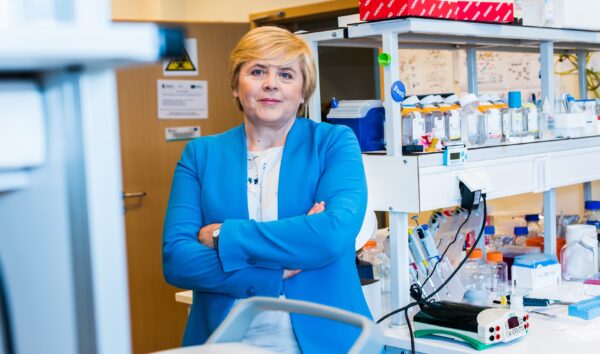Nencki Institute of Experimental Biology of the Polish Academy of Science has over 100 years of experience. Currently, it has the A + category, which is assigned to institutes with the highest scientific potential. Since February 2018, Prof. Agnieszka Dobrzyn has been the director of the Institute; she is also the head of the Laboratory of Cell Signals and Metabolic Disorders. The Institute’s structure includes the Molecular Neurobiology Laboratory, headed by Prof. Bozena Kaminska-Kaczmarek. In 2021, the Professor was awarded the 2021 Foundation for Polish Science Prize, called the “Polish Nobel”, in the field of life and Earth sciences, for discovering the mechanisms that cause malignant gliomas to reprogramme immune cells so they support the development of these brain tumours.

Photo: prof. Bożena Kamińska-Kaczmarek_fot.OneHD_Archowum FNP
We asked the Professor how the Laboratory of Molecular Neurobiology had been founded, what research had been carried out there, and how she had created such a great team.
What was the idea behind the creation of the Laboratory of Molecular Neurobiology at the Nencki Institute of Experimental Biology of the Polish Academy of Science in Warsaw?
The Laboratory of Molecular Neurobiology was established in 2013 as part of the Neurobiology Center at the Nencki Institute. I entered the competition and got the chance to build a new laboratory from scratch, focused on cognitive and translational research in the field of neuro-oncology. The idea of establishing the Neurobiology Center was very ambitious, as we wanted to create a new centre equipped with the latest generation equipment for imaging processes at the level of a cell and whole organism, and with next-generation sequencing equipment, which for the first time allowed us to conduct research on the entire genomes. For example, the first comprehensive ‘Atlas’ of regulatory regions active in glioblastomas of various grades was developed, which revealed the deregulation of the mechanisms controlling gene expression. A new mechanism driving the invasiveness of malignant brain tumours has been identified. Using next-generation sequencing, the regulatory and open chromatin regions in freshly removed brain tumour samples were mapped, and then the team analysed how genes were regulated in benign and malignant gliomas. The Atlas of regulatory places was created thanks to the interdisciplinary nature of the scientific activity and cooperation of the Nencki Institute employees with bio IT specialists from the University of Warsaw and the Institute of Computer Science of the Polish Academy of Sciences. The participation of bio IT specialists enabled a very broad bio IT analysis of genome-wide data, and the creation of the Atlas and a publicly available database (http://regulomics.mimuw.edu.pl/GliomaAtlas). Thanks to the introduction of new techniques, sequencing of the genome and transcriptome of pairs of primary and recurrent gliomas was performed, and it was shown that recurrent gliomas have a different genetic change profile, suggesting tumour evolution after treatment. Examination of transcriptome profiles showed that immune cell infiltration in recurrent gliomas indicates an accumulation of immature immune cells unable to fight the tumour.
What is the research conducted by your team currently focusing on?
Recently, new technologies have appeared that allow us to study phenomena at the level of a single cell. We have developed a method for efficiently sorting immune cells from glioblastoma brains and examined single cell transcripts to characterise the diversity of infiltrating cells and their functions. We have shown that immune cells, microglia residing in the brain and monocytes / macrophages migrating from the blood, do not destroy glioblastoma, and that only in the tumour microenvironment, monocytes transform into immunosuppressive macrophages. We have also detected sex-related differences, and greater MHCII complex reactivity in the glioblastoma microglia developing in male mice, which may explain the higher frequency of male gliomas. We are currently carrying out a fascinating project in which we will investigate how specific changes in the glioblastoma genome modify the tumour microenvironment and the response to immunotherapy. We have collected 12 types of mouse gliomas from around the world that have exactly the same changes as human gliomas, and we will be very precise about when and how this will change the tumour microenvironment and response to immunotherapy. We also have a very interesting collaboration with chemists on new drug carriers to facilitate crossing the blood-brain barrier and improve drug delivery to the tumour. I am the coordinator of the international project “Euronanomed3”, which will finance the testing of various nanocarriers of therapeutic molecules invented by us.
There are many doctoral students in your team, which confirms that the direction of the research is interesting for the young generation. Why are they deciding to pursue a career in science? I am asking this because we often hear in the media that working in science is much less prospective for a young person than working in business.
I do work with a lot of PhD students. I make sure that they have decent scholarships and opportunities for personal development through participation in international conferences and trips to reputable centres. I believe that working in innovative projects such as ours, although difficult, is a great adventure. You have to learn new techniques all the time, research is not uniform, you have to do different things, because projects are developing dynamically. Of course, you need to have a certain resistance to stress and great curiosity, but this is compensated for by the fact that our research is of great practical importance and may soon change the therapies for malignant tumours. I believe my colleagues are aware of the innovative nature of this research and of pushing the boundaries of science.
Source:


